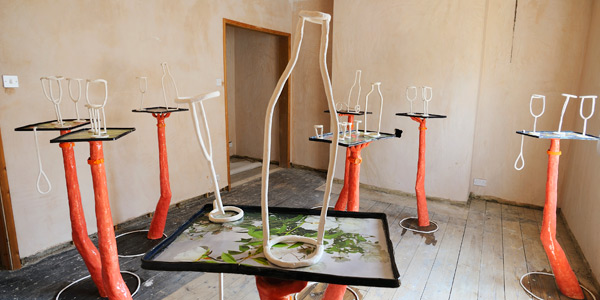Following the announcement that Central Saint Martins Fine Art tutor Emma Hart has won the 2016 Max Mara Art Prize for Women, we spoke to her about her practice, her plans for the six-month residency in Italy she’s been awarded, and what she thinks about gender-specific prizes.
Can you tell us a bit about your work?
It comes from a frustration that photography, rather than revealing real experience, screens it off, and turns events into bitesize chunks that we can manage, consume and keep distant. I wanted to see if the camera could work to transmit a more overwhelming live experience. This demand on the camera, then becomes a demand on art, that it too offers real experiences, or situations for the viewer to enter in to, rather than just stand outside of and contemplate.
Clay is a raw, immediate, and messy substance which I scale up to create sculptural situations. These put the viewer under social pressure, such as ceramic arms straining to offer them drinks, or crying eyes peering over ceramic clipboards at the audience. Clay gets me to work, behind pictures, to go beyond surface appearances and deal with inner doubts. It allows me to put feelings on a surface; punch it, kick it. Scratch it, bite it, stroke it. It connects with how I am feeling.
You’ve spoken before about your work being inspired by the overwhelming strains of busy, modern London – is working at Granary Square a contributing factor?
Teaching is a serious commitment (one I’m fairly new to) and that I have had to factor it in to my art making process. I find teaching richly rewarding, and it has given me a new space to channel my research. I meet a huge range of students and use teaching as a way to have a meaningful exchange of ideas with artists, testing out together what new experiences art can offer.
Can you tell us a bit about the proposal you submitted for the Max Mara Prize?
I will be researching through a unique Italian lens: the power and psychology of the family, unravelling how we form and need relationships, and testing if we can form new relationships with artworks. All with a greatly new improved ceramic twist, as I get to spend time with expert maiolica makers. Maiolica historically is gifted to celebrate Italian family events, so it’s relevant for practical and conceptual reasons.
What are you going to be working on in Italy as part of your residency?
I go for two months to Milan, researching the work of Mara Selvini Palazzoli, a pioneering psychologist who developed the Milan School Of Family Therapy, where relationships and family systems are used as a form of psychotherapy. I then go to Faenza to spend time at the Museo Internazionale della Ceramica di Faenza and then will undertake a ceramics residency at Museo Carlo Zauli, learning new methods with clay and glaze.
A recent statistic revealed that only 30% of artists represented by galleries in London are female, yet here at UAL over 70% of students are female. Do you think it’s important to have gender-specific prizes?
Every two years the Max Mara prize comes up with a great list of artists who happen to be women. We shouldn’t need a prize for female artists – but while there are really strong women working as curators and museum directors, it’s still a mystery to me why women artists are still under-represented in commercial galleries and major public exhibitions. After all, most art students are women, and there are many great dealers who are women out there.
More information:
– Art programme
– MA Fine Art
– BA Fine Art

